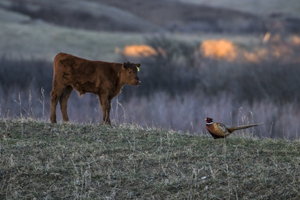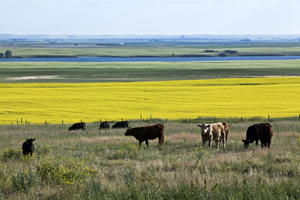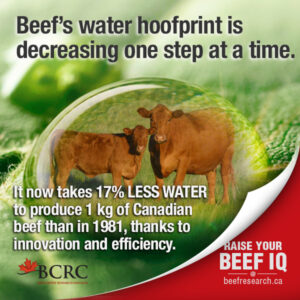Isn’t Beef Canada’s Ultimate Plant Based Protein?

Editor’s note: this article is also available in French. Download the translated version here.
The profile of plant-based proteins has grown exponentially over the past decade. Food companies are investing heavily in the development of new vegetarian and vegan products like new meatless burgers made from peas, which are quickly going mainstream. The spotlight is extra bright on Earth Day.
As plant-based protein options become more abundant, people can’t help but wonder how they compare to meat. Is producing plant-based proteins better for the environment than livestock? Are meatless options healthier? Should I replace beef burgers with plant-based patties?
Environmentally, agriculturally and nutritionally speaking, Canadians need legumes and meat. There’s no good reason to choose one over the other – it’s best to choose both. In fact, beef production provides unique environmental and human health benefits, so it’s important to keep beef in the mix.

Beef cattle support natural wildlife habitats in Canada
The beef sector uses one third of Canada’s agricultural land while providing two thirds of the country’s wildlife habitat. These lands are home to at risk species like the swift fox, sage grouse, and monarch butterfly among 579 birds, mammals, reptiles and amphibians that need uncultivated land for feeding, breeding, and shelter. When grasslands are lost to cultivation, vulnerable species decline.
One of the planet’s most endangered ecosystems is being preserved because of Canadian beef cattle
Canadian beef production is centered on the Northern Great Plains, one of only four temperate grasslands remaining on the planet. According to the World Wildlife Fund, half of the Northern Great Plains have already been lost to cultivated agriculture. These losses continue. Between 2000 and 2012, 23% of Canada’s remaining pastureland was converted to cultivated agriculture. As the environmental hoofprint of Canadian beef is shrinking, crop production’s plowprint is increasing. Increased cattle numbers can help slow or even reverse that trend, protecting the Northern Great Plains.

Grassland in Canada evolved with grazing pressure from buffalo and other large ruminants. Grazing is essential for complex grassland ecosystems to flourish. Because cattle primarily consume grass, the presence of woody shrubs can increase with grazing. Shrubs provide winter feed for deer and other browsers. Without grazing, grass gradually out competes the shrubs, eliminating the browsers’ preferred winter food source and resulting in long-term population declines in deer populations.
Like the rainforest, Canada’s native grasslands are a unique and precious resource. Cultivating grasslands for crop production may destroy resources we’ll need in the future. For example researchers at the University of Lethbridge are studying components of the buffalo bean (a plant native to the Canadian prairies) to treat cancer.
Cattle can utilize and support land that cannot or should not be cultivated
Some land is not suited for cultivation because of climate limitations, marginal soil, or because it is too steep, rocky, swampy or forested. Cultivating these soils increases soil erosion and often requires greater use of fertilizers and other inputs to make them productive. Cattle allow high quality beef protein to be produced from land that cannot or should not be farmed.

Healthy grasslands help fight climate change
Perennial grasses store carbon in the soil – up to three times as much as annual crops do. Reseeding cultivated land to grass in the 1930’s (to combat soil erosion in the Dirty 30’s) and improving grazing practices in the 1950’s have shifted the Canadian prairies from a net carbon source to a net carbon sink. Although cultivation and poor grazing management can lead to major soil carbon losses, appropriate grazing practices can reverse soil degradation, improve grassland quality, economic sustainability and resilience to climate change. This reinforces the need to keep grassland as grassland.
Cattle and crops go well together
Crop rotations that include animal grazing may have fewer weeds and need less herbicide than rotations that don’t include grazing. Adding composted manure to cropland increased soil organic matter by 19%, improved soil moisture content, and improved soil microbial activity. Fertilizing with animal manure can produce similar or higher crop yields than synthetic fertilizers. Winter bale or swath grazing of cattle also improves soil nutrient levels.

Cattle aren’t eating your lunch
Cattle can feed on chaff, stems and regrowth after crops are harvested. Not all crops that are harvested meet the quality requirements for milling flour or brewing beer, but still make high quality feed for cattle. Cattle also eat the meals, screenings, cracked seeds, distillers’ grains, and other byproducts from the crushing, milling, brewing and processing of oilseeds, pulses and grains. The added feed value of these byproducts benefits the crop sector, particularly in years when weather during growing or harvesting doesn’t cooperate. People and cattle do not compete for the same foods.
Even in Canada’s grain-finished beef system, over 80% of the overall feed consumed by beef cattle is high fiber forage that humans and other livestock can’t digest. Unlike humans, pigs and chickens, cattle produce a net gain in protein by converting indigestible plant fiber and other non-protein feeds into high quality beef protein. Beef is Canada’s ultimate plant-based protein.

The beef sector is working harder to do better
All food production inevitably requires natural resources like water and produces greenhouse gas emissions, but Canada’s beef producers are among the most efficient in the world and are continually improving. Canada’s beef cattle use less water and produce less greenhouse gas per pound (or kilogram) than nearly any other place in the world.
Researchers at the University of Manitoba and Agriculture and Agri-Food Canada (AAFC) Lethbridge found that in 2011, producing each pound (or kilogram) of Canadian beef used 17% less water than it did thirty years earlier. Remember the water cycle? Food production is part of that water cycle. All food systems rely on water, but the water is not used up. All water ultimately gets recycled. This team of scientists also found that each pound (or kilogram) of beef produced in 2011 generated 15% less greenhouse gas and 20% less ammonia, and required 29% less breeding stock, 27% fewer harvested cattle and 24% less land compared to 1981.
Canada’s beef research community is continually investigating ways to reduce the sector’s environmental impact, through improved animal health, feed supplements to reduce greenhouse gas emissions, improved forage and feed varieties that use water more efficiently, byproduct feeds, improving feed efficiency, etc.
Canadians benefit from including beef and other unprocessed foods in their diet
Either intentionally or inadvertently, Canada’s new food guide may have left some Canadians with the impression that plant and animal proteins are nutritionally equivalent, that replacing animal protein with plant protein is simple, or benefits human health. The facts say otherwise.
Canada’s per capita beef consumption has declined from its 1976 peak, partly due to misperceptions that Canadian beef contains too much unhealthy fat. In fact, the 74 cooked beef products in the Canadian Nutrient Files average 10% fat (qualifying as “extra lean”), and over half of that fat is unsaturated “healthy” fat. In the meantime, earlier health concerns regarding saturated fat are coming under increased scientific scrutiny.
There is increasing concern that Canadians increased consumption of (ultra)processed foods is responsible for Canada’s increased obesity. As Canada’s per capita beef consumption has dropped by more than half (from 9.5 servings per week in 1976 to 4.3 in 2017), Canada’s adult obesity rate doubled (from 14% in 1978 to 28% in 2014).

Beef has unique nutritional benefits
Beef is nutrient-dense. Beef protein contains all the amino acids people need, in the right proportions. Beef is also an excellent source of iron (needed for the hemoglobin that carries oxygen in the blood and muscles), zinc (required for hundreds of functions in the body), choline (involved in metabolism, memory, mood and muscle control) and vitamin B12 (essential for nerve and brain health). Nutrients from beef (and other animal proteins) are highly digestible and bioavailable, meaning that the human body can access, absorb, and use these nutrients. Many plant-sourced nutrients are less digestible, absorbable and bioavailable, and some nutrients including B vitamins, zinc, iron and some amino acids (particularly methionine, lysine, and/or leucine) require artificial supplementation in many vegetarian or vegan diets.
Beef is important for vulnerable people
Beef provides more protein, amino acids, vitamin B12 and zinc iron per calorie than any plant source. This is particularly important for people who need to meet their nutrient requirements from a limited amount of food. This includes pregnant women, infants, the elderly, and athletes.
Beef and plants go better together
Beef doesn’t contain vitamin A, vitamin C, folate, fiber or some other nutrients. Those nutrients need to come from plants. As omnivores, we need a balanced diet containing both plants and meat to obtain all the nutrients we need. Eating meat also allows humans to better absorb the nutrients available from sources.
Moderation in all things
Over the long run, science reveals both miracle superfoods and nutritional villains to be products of imagination and marketing. Research shows that lean beef is part of a healthy balanced diet, together with a variety of other plant and animal products. Achieving a balanced diet without beef is possible, provided a sufficiently complex combination of plant proteins and other supplements are available. But by including nutrient-dense beef, achieving a healthy, balanced diet is easy, affordable and delicious.
We’re seeing positive change; let’s keep it this way
The rate of grassland loss in the Great Plains slowed in 2017. However, incentives to produce plant-based alternatives to beef threaten efforts to further curtail grassland cultivation and protect this endangered ecosystem.
Projections point to an increase in global beef demand in the coming years. Canada is one of the world’s most environmentally efficient beef producing nations. Displacing beef production from Canada through encouraging a shift to plant-based alternatives will shift beef production to countries with poorer environmental and deforestation practices, increased resource use and emissions, and harm Canadians, the economy and the environment.
Canada’s beef industry provides unique environmental and human health benefits that plant-based alternatives can’t replace.
Click here to subscribe to the BCRC Blog and receive email notifications when new content is posted.
The sharing or reprinting of BCRC Blog articles is welcome and encouraged. Please provide acknowledgement to the Beef Cattle Research Council, list the website address, www.BeefResearch.ca, and let us know you chose to share the article by emailing us at info@beefresearch.ca.
We welcome your questions, comments and suggestions. Contact us directly or generate public discussion by posting your thoughts below.